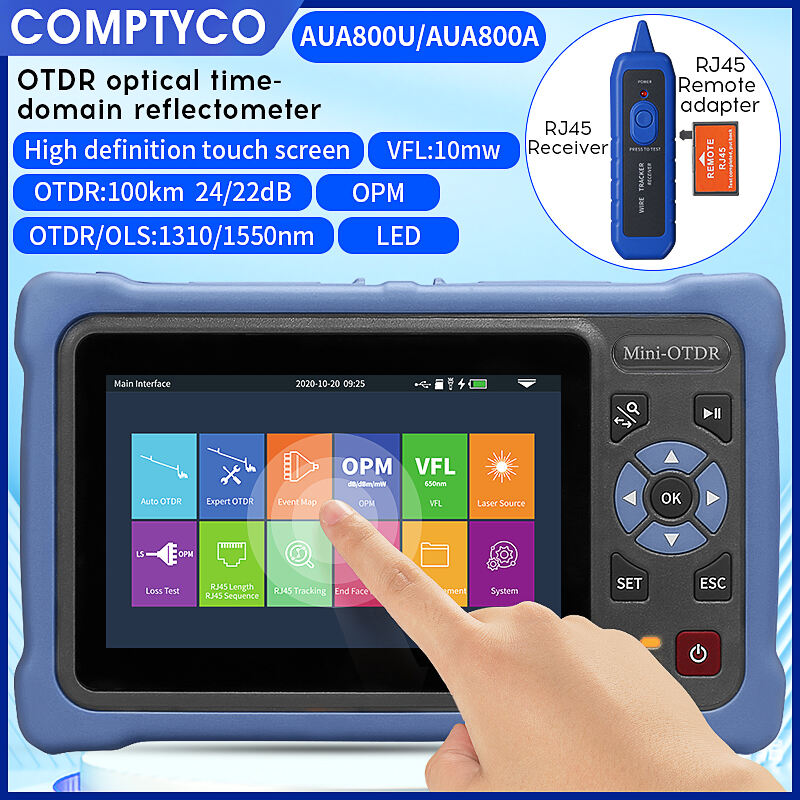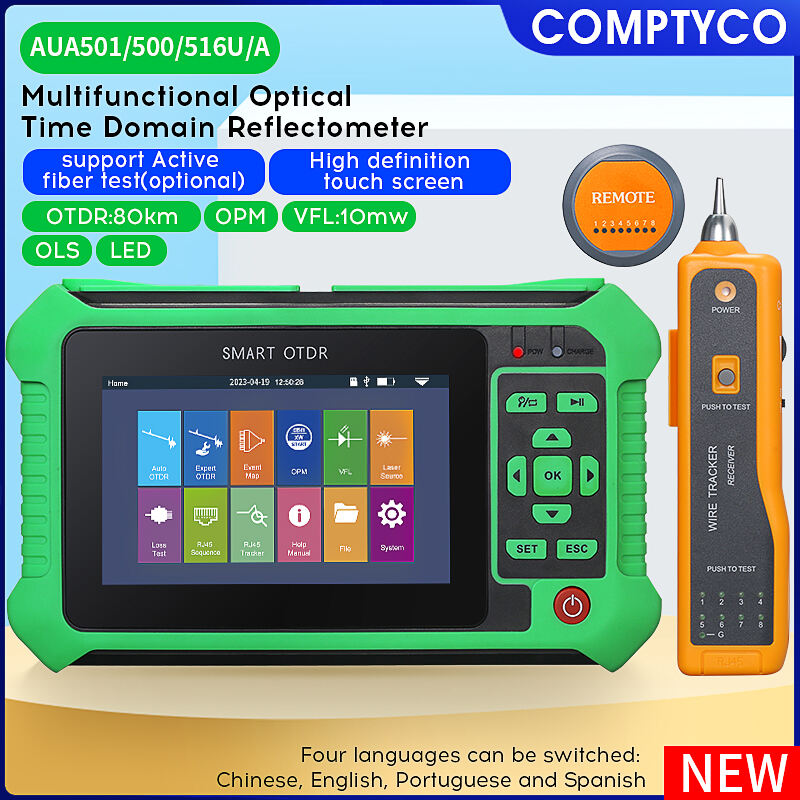How Can OTDR Improve the Efficiency of Fiber Optic Network Maintenance?
Introduction to OTDR in Fiber Optic Networks
Fiber optic networks are the backbone of modern communication systems, supporting everything from high-speed internet to cloud computing and data centers. Ensuring their reliability and efficiency is a priority for network operators, service providers, and enterprises alike. Optical Time Domain Reflectometer, commonly referred to as OTDR, has become an essential tool in the installation, troubleshooting, and maintenance of these networks. OTDR is designed to analyze the integrity of optical fibers by sending pulses of light into the cable and measuring the reflections caused by faults, splices, connectors, or breaks. By providing detailed insight into fiber conditions, OTDR greatly improves the efficiency of network maintenance and minimizes downtime.
The Function and Operation of OTDR
Principles of OTDR Technology
OTDR works by transmitting a series of optical pulses into a fiber and measuring the light scattered or reflected back from different points along the fiber. Any irregularities such as bends, splices, or faults reflect part of the light back to the instrument. By calculating the time it takes for the light to return and analyzing the intensity of reflections, OTDR creates a trace or graphical representation of the fiber. This trace helps technicians identify and locate specific issues along the cable with high precision.
Key Capabilities
An OTDR provides detailed information about the length of the fiber, overall attenuation, splice loss, connector loss, and the location of breaks or faults. This makes it a versatile tool not only for troubleshooting but also for documenting network conditions during installation and for periodic maintenance checks.
The Role of OTDR in Network Maintenance
Rapid Fault Detection
One of the most important ways OTDR improves efficiency is by quickly locating faults. In traditional maintenance practices, technicians would have to perform time-consuming inspections or rely on trial-and-error methods to identify the location of a problem. OTDR pinpoints the exact distance to a fault, splice, or connector, allowing technicians to target repairs with precision. This drastically reduces downtime and minimizes service disruption.
Documentation and Benchmarking
During the installation of new fiber optic networks, OTDR can create baseline traces that serve as reference points for future maintenance. These traces document the condition of the network when it was first deployed, making it easier to compare later measurements and identify changes or degradations over time. By maintaining accurate records, operators can ensure that maintenance is proactive rather than reactive.
Preventive Maintenance
OTDR supports preventive maintenance by detecting small issues before they evolve into major problems. For example, it can reveal slight increases in splice loss or minor bends that, if left unchecked, could lead to significant signal degradation. Detecting and addressing these issues early improves network reliability and reduces the need for emergency repairs.

Efficiency Gains through OTDR
Reduced Downtime
With the ability to locate faults quickly and accurately, OTDR significantly reduces network downtime. For service providers, this means fewer customer complaints and less revenue loss from outages. For enterprises, it ensures business continuity and reliable access to critical applications.
Cost Savings
By eliminating the need for extensive manual inspections and trial-and-error fault detection, OTDR reduces labor costs. Its ability to identify problems precisely also means less time is spent searching for faults, and fewer unnecessary repairs are performed. These savings accumulate significantly over the lifespan of a network.
Improved Workforce Productivity
Technicians equipped with OTDR can work more efficiently because they have access to detailed diagnostics in real time. This enables them to make informed decisions quickly, complete tasks faster, and handle more maintenance operations within the same time frame.
Applications of OTDR in Different Fiber Optic Scenarios
Long-Haul Networks
In long-distance telecommunications networks, where fiber spans hundreds of kilometers, OTDR is invaluable for monitoring signal attenuation and identifying faults that may occur far from access points. Without OTDR, locating faults in such networks would be nearly impossible in a reasonable time frame.
Data Centers
Data centers rely on high-density fiber optic cabling to connect servers, storage, and network devices. OTDR helps ensure that these connections remain optimized by verifying the quality of splices and connectors, and by detecting any degradation that could impact performance.
Metropolitan and Access Networks
Urban access networks that serve large numbers of users need to minimize downtime. OTDR allows quick detection of fiber breaks caused by construction, weather, or accidental damage, enabling rapid response and restoration of service.
FTTx and Passive Optical Networks
Fiber-to-the-home and other passive optical networks present unique challenges due to their branching structures. Modern OTDR instruments are designed to handle these configurations, helping providers maintain service quality across multiple customer connections.
Integration of OTDR with Modern Tools
Handheld and Portable OTDR Devices
Advances in technology have made OTDR units more compact and portable, allowing technicians to carry them easily into the field. These handheld devices maintain high accuracy while providing user-friendly interfaces that simplify operation even for less experienced personnel.
Remote OTDR Testing
In some networks, OTDR units are integrated into remote monitoring systems. This allows continuous testing of fiber conditions without sending technicians to the site. Remote OTDR testing is particularly valuable in large-scale or geographically dispersed networks, as it reduces travel time and ensures immediate detection of issues.
Software Integration and Automation
Modern OTDR tools often integrate with software platforms that automate data collection, analysis, and reporting. This not only streamlines maintenance but also ensures consistency and accuracy in evaluating fiber conditions. Automated alerts can notify technicians of abnormalities before they escalate, improving proactive maintenance strategies.
Challenges and Considerations
Training and Expertise
While OTDR is a powerful tool, interpreting its traces requires training and expertise. Misinterpretation can lead to incorrect diagnoses and unnecessary repairs. Investing in training for technicians is essential to maximize the benefits of OTDR.
Initial Investment
The cost of acquiring OTDR equipment can be significant, particularly for smaller organizations. However, the long-term savings in reduced downtime, improved efficiency, and preventive maintenance often outweigh the upfront investment.
Environmental and Network Conditions
Factors such as fiber length, quality, and environmental conditions can affect OTDR accuracy. Choosing the right OTDR settings and equipment for specific applications is necessary to ensure reliable results.
The Future of OTDR in Fiber Optic Maintenance
Artificial Intelligence and Machine Learning
The future of OTDR will likely involve greater integration with artificial intelligence and machine learning. These technologies can analyze OTDR traces automatically, detect subtle patterns, and provide actionable insights without requiring extensive human interpretation.
Cloud-Based Data Management
As networks grow larger and more complex, cloud-based OTDR data management will enable centralized monitoring and analysis. This will allow network operators to compare performance across regions, identify widespread issues, and optimize maintenance strategies globally.
Integration with Smart Networks
Future fiber optic networks will be increasingly self-monitoring and self-healing. OTDR will play a critical role in these systems by continuously feeding data into intelligent platforms that adjust network parameters automatically in response to detected faults or degradations.
Conclusion
OTDR has become an indispensable tool for improving the efficiency of fiber optic network maintenance. By providing rapid fault detection, accurate documentation, preventive maintenance capabilities, and integration with modern technologies, OTDR reduces downtime, saves costs, and enhances the productivity of maintenance teams. Whether in long-haul networks, data centers, metropolitan access networks, or FTTx deployments, OTDR ensures the reliability and performance of fiber infrastructures. Looking ahead, advances in AI, cloud integration, and smart network technologies will make OTDR even more powerful, further solidifying its role in the future of communication networks.
FAQ
What is OTDR used for in fiber optic networks?
It is used to detect, locate, and analyze faults, splices, connectors, and other events along optical fibers, ensuring efficient maintenance and troubleshooting.
How does OTDR improve network maintenance?
By quickly pinpointing issues and providing detailed traces, it reduces downtime, saves costs, and enables preventive maintenance.
Can OTDR be used in long-distance networks?
Yes, it is particularly valuable in long-haul networks where faults may occur over hundreds of kilometers.
Is OTDR suitable for data centers?
Yes, it helps verify splices and connectors, detect degradation, and maintain optimal fiber performance in dense cabling environments.
Do technicians need training to use OTDR?
Yes, interpreting OTDR traces requires knowledge and practice, making training essential for accurate results.
Is OTDR expensive to implement?
The initial cost can be high, but long-term savings from improved efficiency and reduced downtime outweigh the investment.
Can OTDR detect minor fiber issues?
Yes, it can detect small increases in splice loss, minor bends, and other degradations before they cause major failures.
Does OTDR integrate with modern software tools?
Yes, many OTDR units work with software platforms for automated analysis, cloud storage, and remote monitoring.
How does OTDR support preventive maintenance?
It identifies small irregularities early, allowing technicians to address issues before they escalate into major problems.
What future trends will shape OTDR technology?
Artificial intelligence, cloud-based data management, and integration with self-healing smart networks will drive the future of OTDR.
Table of Contents
- Introduction to OTDR in Fiber Optic Networks
- The Function and Operation of OTDR
- The Role of OTDR in Network Maintenance
- Efficiency Gains through OTDR
- Applications of OTDR in Different Fiber Optic Scenarios
- Integration of OTDR with Modern Tools
- Challenges and Considerations
- The Future of OTDR in Fiber Optic Maintenance
- Conclusion
-
FAQ
- What is OTDR used for in fiber optic networks?
- How does OTDR improve network maintenance?
- Can OTDR be used in long-distance networks?
- Is OTDR suitable for data centers?
- Do technicians need training to use OTDR?
- Is OTDR expensive to implement?
- Can OTDR detect minor fiber issues?
- Does OTDR integrate with modern software tools?
- How does OTDR support preventive maintenance?
- What future trends will shape OTDR technology?







